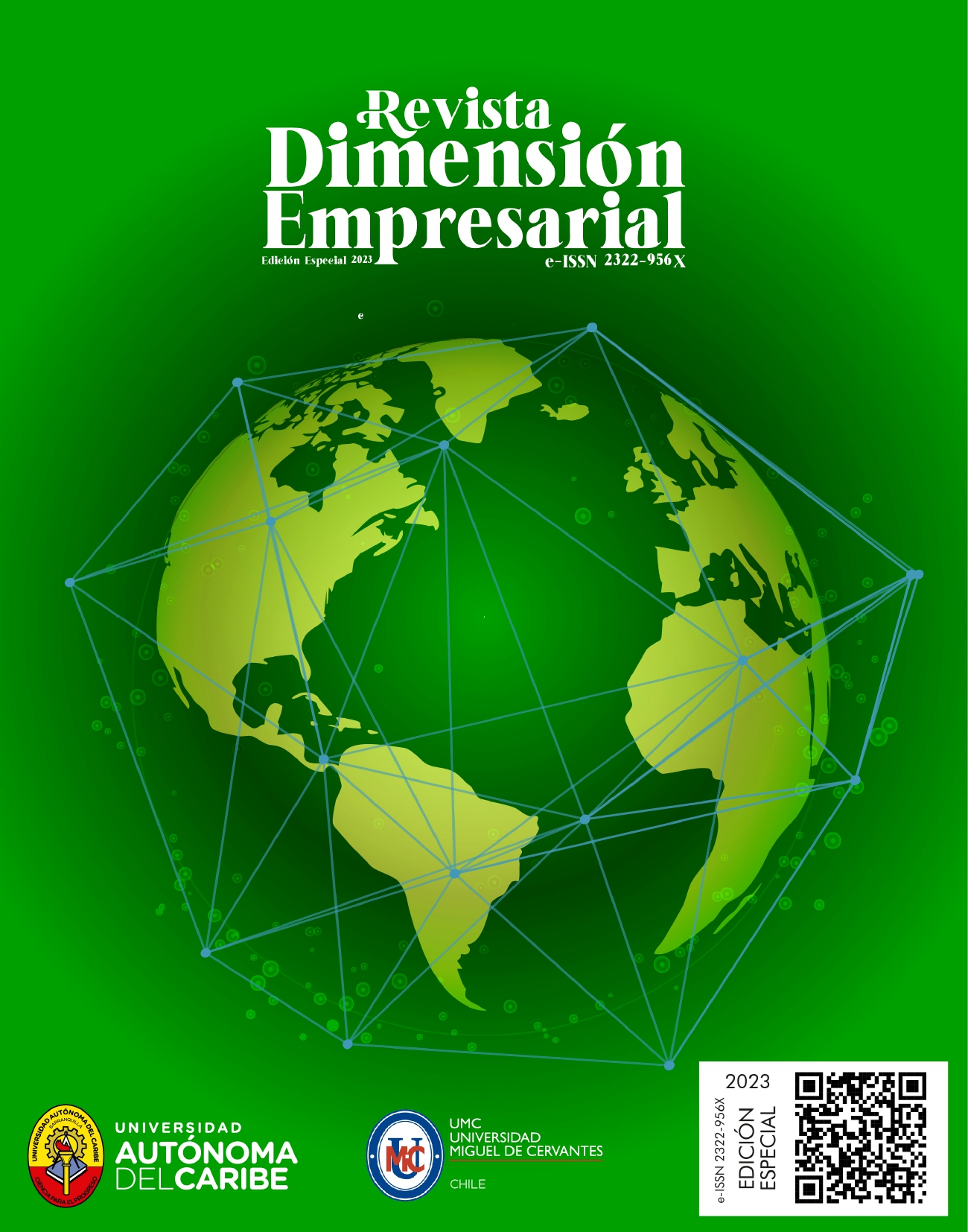Discurso mediático sobre las capacidades dinámicas chilenas
DOI:
https://doi.org/10.15665/dem.v21i1.3462Palabras clave:
Capacidades Dinámicas, Chile, Análisis de DiscursoResumen
En el marco del contexto social y económico chileno, se realiza una investigación cualitativa con el objetivo de describir las características conceptuales de los discursos mediáticos asociados a las capacidades dinámicas de las organizaciones, identificando 16 constructos significativos que articulan un discurso, el cual establece las causas políticas involucradas en el dinamismo del entorno y los fundamentos sociales de las capacidades de empresas. El resultado es un mapa de procesos que describe el modelo mental presente de forma común en los discursos mediáticos analizados.
Citas
Acs, Z. J., Audretsch, D. B., y Lehmann, E. E. (2013). The knowledge spillover theory of entrepreneurship. Small business economics, 41, 757-774.
Andrews, K.R. (1971) The Concept of Corporate Strategy. Irwin, Homewood. Open Journal of Business and Management, Vol.2 No.3, July 25, 2014
Augusto Felício, J., Couto, E., y Caiado, J. (2014). Human capital, social capital and organizational performance. Management decision, 52(2), 350-364.
Bogers, M., Chesbrough, H., Heaton, S., y Teece, D. J. (2019). Strategic management of open innovation: A dynamic capabilities perspective. California Management Review, 62(1), 77-94.
Billi, M., Urquiza Gómez, A., & Feres Klenner, C. (2017). Environmental communication and non-conventional renewable energy projects. content analysis of chilean mass media. Revista Latina De Comunicacion Social, 72, 1218-1237. doi:10.4185/RLCS-2017-1216
Camus, P. A., Ponce, N., Contreras, F. C., & Del Valle Tapia, M. (2018). Critical discourse analysis: The higher education reform in chile in written media. [Análisis crítico del discurso: La reforma a la educación superior en Chile en medios de comunicación escritos] Revista Colombiana De Educacion, (75), 77-98. doi:10.17227/rce.num75-8102
Chamberlin, E. (1933) The Theory of Monopolistic Competition. The Economic Journal, Volume 43, Issue 172, 1 December, Pages 661–666, https://doi.org/10.2307/2224511
Cohen, W. M., y Levinthal, D. A. (1990). Absorptive capacity: A new perspective on learning and innovation. Administrative science quarterly, 128-152.
Cyert, R. and March, J. (1963) A Behavioral Theory of the Firm. Prentice-Hall, Englewood Cliffs.
D’Aveni RA. 1994. Hypercompetition: Managing the Dynamics of Strategic Maneuvering. Free Press: New York.
Damanpour, F. (1991). Organizational innovation: A meta-analysis of effects of determinants and moderators. Academy of management journal, 34(3), 555-590.
Davidsson, P. (2015). Entrepreneurial opportunities and the entrepreneurship nexus: A re-conceptualization. Journal of business venturing, 30(5), 674-695.
Giuliani, E., y Bell, M. (2005). The micro-determinants of meso-level learning and innovation: evidence from a Chilean wine cluster. Research policy, 34(1), 47-68.
Herrera, D. I. (2020). Discourse analysis in the hybrid media system: A methodological approach. [Análisis discursivo en sistemas híbridos de medios: Una aproximación metodológica] Logos: Revista De Linguistica, Filosofia y Literatura, 30(2), 314-330. doi:10.15443/RL3024
Helfat, C. E., & Peteraf, M. A. (2009). Understanding dynamic capabilities: progress along a developmental path. Strategic Organization, 7(1), 91–102. https://doi.org/10.1177/1476127008100133
Honda, A., de Araujo Oliveira, S. R., Ridde, V., Zinszer, K., y Gautier, L. (2023). Attributes and Organizational Factors that Enabled Innovation in Health Care Service Delivery during the COVID-19 Pandemic–Case Studies from Brazil, Canada and Japan. Health Systems y Reform, 9(2), 2176022.
Hoppe, M. (2018). The Prime Mover Matrix: A Conversation Piece for Building Strategic Innovative Capacity. Technology Innovation Management Review, 8(7), 5-13.
Jin, C. H., y Lee, J. Y. (2020). The impact of entrepreneurship on managerial innovation capacity: The moderating effects of policy finance and management support. South African journal of business management, 51(1), 1-13.
Kitsios, F., y Kamariotou, M. (2021). Information Systems Strategy and Innovation: Analyzing Perceptions Using Multiple Criteria Decision Analysis. IEEE Transactions on Engineering Management.
Laursen, K., y Salter, A. (2006). Open for innovation: the role of openness in explaining innovation performance among UK manufacturing firms. Strategic management journal, 27(2), 131-150.
Lessard, D., Teece, D. J., y Leih, S. (2016). The dynamic capabilities of Meta‐multinationals. Global Strategy Journal, 6(3), 211-224.
Mancuso, I., Petruzzelli, A. M., y Panniello, U. (2023). Innovating agri-food business models after the Covid-19 pandemic: The impact of digital technologies on the value creation and value capture mechanisms. Technological Forecasting and Social Change, 190, 122404.
Martínez Ardila, H. E., Mora Moreno, J. E., y Camacho Pico, J. A. (2020). Networks of collaborative alliances: the second order interfirm technological distance and innovation performance. The Journal of Technology Transfer, 45, 1255-1282.
McGrath, R. G. (2001). Exploratory learning, innovative capacity, and managerial oversight. Academy of management journal, 44(1), 118-131.
Moon, T. (2010). Organizational cultural intelligence: Dynamic capability perspective. Group y Organization Management, 35(4), 456-493.
Mowery, D. C., Malerba, F., Dosi, G., y Teece, D. J. (2019). Introduction: Nathan Rosenberg as a founding father of the economics of innovation. Industrial and Corporate Change, 28(2), 283-288.
Nelson, R. y Winter, S. (1982) An Evolutionary Theory of Economic Change. Harvard University Press, Cambridge, MA.
Peteraf, M. A. (1993). The cornerstones of competitive advantage: a resource‐based view. Strategic management journal, 14(3), 179-191.
Petit, N., y Teece, D. J. (2021). Innovating big tech firms and competition policy: favoring dynamic over static competition. Industrial and Corporate Change, 30(5), 1168-1198.
Pittaway, L., Robertson, M., Munir, K., Denyer, D., y Neely, A. (2004). Networking and innovation: a systematic review of the evidence. International journal of management reviews, 5(3‐4), 137-168.
Ricardo, D. (1817). On the Principles of Political Economy and Taxation (John Murray, London). In: Sraffa, P., Ed., The Works and Correspondence of David Ricardo, Vol. 1, Cambridge University Press, Cambridge, 1951.
Richardson, G. B. (1972) The Organisation of Industry, The Economic Journal, Volume 82, Issue 327, Pages 883–896, https://doi.org/10.2307/2230256
Schilling, M. A., y Phelps, C. C. (2007). Interfirm collaboration networks: The impact of large-scale network structure on firm innovation. Management science, 53(7), 1113-1126.
Schumpeter, J. A. (1950). Capitalism, Socialism, and Democracy: Third Edition. Reino Unido: HarperCollins.
Smith, A. (1776). The Wealth of Nations: An inquiry into the nature and causes of the Wealth of Nations. Harriman House Limited, 2010.
Son, I., Kim, J., Park, G., y Kim, S. (2018). The impact of innovative technology exploration on firm value sustainability: The case of part supplier management. Sustainability, 10(10), 3632.
Teece, D. J. (2007). Explicating dynamic capabilities: the nature and microfoundations of (sustainable) enterprise performance. Strategic management journal, 28(13), 1319-1350.
Teece, D. J., Pisano, G., y Shuen, A. (1997). Dynamic capabilities and strategic management. Strategic management journal, 18(7), 509-533.
Thakker, A., y Sun, D. (2023). Handmade papers: Innovation, Technology, and Design. Journal of Natural Fibers, 20(1), 2187505.
Williamson, O. E. (1999). Strategy research: governance and competence perspectives. Strategic management journal, 20(12), 1087-1108.
Zaheer, A., y Bell, G. G. (2005). Benefiting from network position: firm capabilities, structural holes, and performance. Strategic management journal, 26(9), 809-825.
Descargas
Publicado
Cómo citar
Número
Sección
Licencia
Derechos de autor 2024 David Álvarez-Maldonado

Esta obra está bajo una licencia internacional Creative Commons Atribución-NoComercial-SinDerivadas 4.0.
Tenga en cuenta que al presionar el botón "guardar y continuar" que está al final, Usted está asumiendo todos los compromisos éticos y legales que aquí se enuncian. Ellos establecen las responsabilidades de la legislación en materia de derechos de propiedad intelectual. Para esto se asume que quien está efectuando la acción de presentar el escrito obra de buena fe y se representa a sí mismo y a los demás autores del artículo postulado.
En este sentido, los autores conservan todos los derechos de los cuales son titulares y autorizan la reproducción gratuita del documento enviado. En el evento de ser necesario, asumirán, al presionar el botón "guardar y continuar", la responsabilidad legal derivada de los derechos patrimoniales los cuales son gratuitos en razón al no cobro por ningún procedimiento de la Revista.
En consecuencia, El(Los) autor(es) representados por quien adelanta la postulación del artículo a evaluación y eventual publicación,
Declaro(amos):
1. Que soy (somos) el (los) autor(es) del artículo {aquí va el nombre del artículo colocado automáticamente}.
2. Que ésta es una obra original conforme a la ley de propiedad intelectual de derechos de autor colombiana.
3. Que el contenido del artículo de la referencia no ha sido publicado y que no se presentará a ningún otro medio de publicación en soporte escrito o electrónico antes de conocer la decisión del Comité Editorial de Dimensión Empresarial.
4. Que el firmante de esta certificación garantiza que el compromiso que aquí adquiere no infringe ningún tipo derechos de terceros.
5. Que la autorización de publicación incluye su archivo electrónico y su adaptación, de ser necesario, para su incorporación en la red o en cualquier formato electrónico o base de datos, así como anexar los metadatos necesarios para realizar el registro de la obra, marcas de agua o cualquier otro sistema de seguridad o de protección.
6. Que la autorización de publicación incluye la reproducción en soportes digitales. Así como su distribución y la puesta a disposición a través de archivos institucionales a través de Internet, distribuir copias, y exhibirlo en Colombia y fuera del país, así como incluir el artículo en índices nacionales e internacionales.
7. Que el autor asume toda la responsabilidad, incluyendo las indemnizaciones por daños, que pudieran ejercitarse contra la Universidad Autónoma del Caribe por terceros que vieran infringidos sus derechos e intereses a causa de la cesión.
Por su parte, Dimensión Empresarial se obliga a respetar, en todo caso, los derechos del autor contenido en el artículo 30 de la Ley 23 de 1982, o cualquiera posterior a esta y pondrá el artículo a disposición de los usuarios de la Revista para que hagan un uso legítimo de él, según lo permitido por la legislación aplicable, siempre que se cite su autoría, no se obtenga beneficio comercial, y no se realicen obras derivadas.
Los autores/as se comprometen a aceptar las condiciones de esta nota de propiedad intelectual, que se aplicarán a este envío cuando sea publicado en esta revista (más abajo se pueden añadir comentarios al editor/a).




